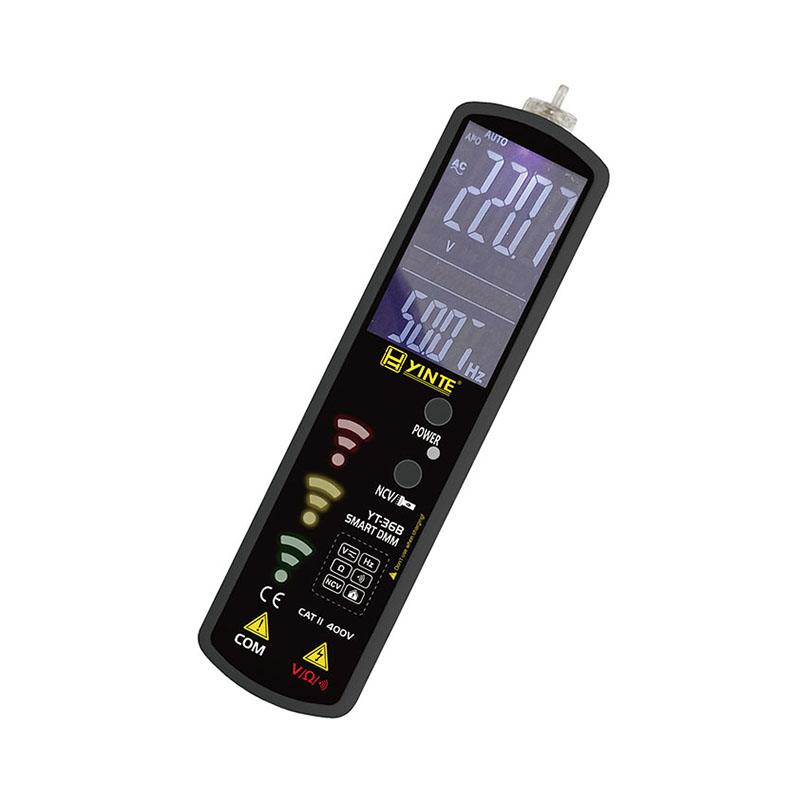- English
- Español
- Português
- русский
- Français
- 日本語
- Deutsch
- tiếng Việt
- Italiano
- Nederlands
- ภาษาไทย
- Polski
- 한국어
- Svenska
- magyar
- Malay
- বাংলা ভাষার
- Dansk
- Suomi
- हिन्दी
- Pilipino
- Türkçe
- Gaeilge
- العربية
- Indonesia
- Norsk
- تمل
- český
- ελληνικά
- український
- Javanese
- فارسی
- தமிழ்
- తెలుగు
- नेपाली
- Burmese
- български
- ລາວ
- Latine
- Қазақша
- Euskal
- Azərbaycan
- Slovenský jazyk
- Македонски
- Lietuvos
- Eesti Keel
- Română
- Slovenski
- मराठी
- Srpski језик
Multimeter Measurement Skills (2)
2022-03-31
Multimeter measurement skills (2)
5. Measure the Zener diode: the voltage regulator value of the Zener diode we usually use is generally greater than 1.5V, and the resistance file below R×1k of the pointer meter is powered by the 1.5V battery in the meter. The resistance range below R×1k is the same as measuring the diode, which has complete unidirectional conductivity. However, the R×10k gear of the pointer meter is powered by a 9V or 15V battery. When using R×10k to measure a voltage regulator tube with a voltage regulation value less than 9V or 15V, the reverse resistance value will not be ∞, but a certain value. resistance, but this resistance is still much higher than the forward resistance of the Zener tube. In this way, we can preliminarily estimate the quality of the Zener tube. However, a good voltage regulator must have an accurate voltage regulation value. How to estimate this voltage regulation value under amateur conditions. It's not difficult, just find another pointer watch.
The method is: first place a watch in the R×10k gear, and the black and red test pens are connected to the cathode and anode of the voltage regulator tube respectively. At this time, the actual working state of the voltage regulator tube is simulated, and then another watch is placed on the On the voltage range V×10V or V×50V (according to the voltage regulation value), connect the red and black test leads to the black and red test leads of the watch just now, the voltage value measured at this time is basically this The voltage regulator value of the Zener tube. Saying "basically" is because the bias current of the first watch to the voltage regulator tube is slightly smaller than the bias current in normal use, so the measured voltage regulation value will be slightly larger, but the difference is basically the same . This method can only estimate the voltage regulator tube whose voltage regulation value is less than the voltage of the pointer meter's high voltage battery. If the voltage regulator value of the Zener tube is too high, it can only be measured by means of an external power supply.
6. Measure the triode: usually we use the R×1kΩ file, whether it is an NPN tube or a PNP tube, whether it is a low-power, medium-power, or high-power tube, the be junction cb junction should be measured. Electricity, the reverse resistance is infinite, and its forward resistance is about 10K. In order to further estimate the quality of the tube characteristics, if necessary, the resistance gear should be changed for multiple measurements.
The method is: set the R×10Ω gear to measure the forward conduction resistance of the PN junction is about 200Ω; set the R×1Ω gear to measure the PN junction forward conduction resistance is about 30Ω, if the reading is too large, it can be concluded that the tube Bad features. The meter can also be placed in R×10kΩ for re-measurement. The reverse resistance of the cb junction should also be ∞ for the tube with lower withstand voltage, but the reverse resistance of the be junction may be somewhat, and the needle will be slightly deflected. Similarly, when measuring the resistance between ec (for NPN tube) or ce (for PNP tube) with R×10kΩ, the needle may deflect slightly, but this does not mean that the tube is bad. However, when measuring the resistance between ce or ec with the gear below R×1kΩ, the indication of the meter should be infinite, otherwise there is a problem with the tube. It should be noted that the above measurements are for silicon tubes and not applicable to germanium tubes. But now germanium tubes are also rare. In addition, the so-called "reverse" refers to the PN junction, and the direction of the NPN tube and the PNP tube is actually different.

5. Measure the Zener diode: the voltage regulator value of the Zener diode we usually use is generally greater than 1.5V, and the resistance file below R×1k of the pointer meter is powered by the 1.5V battery in the meter. The resistance range below R×1k is the same as measuring the diode, which has complete unidirectional conductivity. However, the R×10k gear of the pointer meter is powered by a 9V or 15V battery. When using R×10k to measure a voltage regulator tube with a voltage regulation value less than 9V or 15V, the reverse resistance value will not be ∞, but a certain value. resistance, but this resistance is still much higher than the forward resistance of the Zener tube. In this way, we can preliminarily estimate the quality of the Zener tube. However, a good voltage regulator must have an accurate voltage regulation value. How to estimate this voltage regulation value under amateur conditions. It's not difficult, just find another pointer watch.
The method is: first place a watch in the R×10k gear, and the black and red test pens are connected to the cathode and anode of the voltage regulator tube respectively. At this time, the actual working state of the voltage regulator tube is simulated, and then another watch is placed on the On the voltage range V×10V or V×50V (according to the voltage regulation value), connect the red and black test leads to the black and red test leads of the watch just now, the voltage value measured at this time is basically this The voltage regulator value of the Zener tube. Saying "basically" is because the bias current of the first watch to the voltage regulator tube is slightly smaller than the bias current in normal use, so the measured voltage regulation value will be slightly larger, but the difference is basically the same . This method can only estimate the voltage regulator tube whose voltage regulation value is less than the voltage of the pointer meter's high voltage battery. If the voltage regulator value of the Zener tube is too high, it can only be measured by means of an external power supply.
6. Measure the triode: usually we use the R×1kΩ file, whether it is an NPN tube or a PNP tube, whether it is a low-power, medium-power, or high-power tube, the be junction cb junction should be measured. Electricity, the reverse resistance is infinite, and its forward resistance is about 10K. In order to further estimate the quality of the tube characteristics, if necessary, the resistance gear should be changed for multiple measurements.
The method is: set the R×10Ω gear to measure the forward conduction resistance of the PN junction is about 200Ω; set the R×1Ω gear to measure the PN junction forward conduction resistance is about 30Ω, if the reading is too large, it can be concluded that the tube Bad features. The meter can also be placed in R×10kΩ for re-measurement. The reverse resistance of the cb junction should also be ∞ for the tube with lower withstand voltage, but the reverse resistance of the be junction may be somewhat, and the needle will be slightly deflected. Similarly, when measuring the resistance between ec (for NPN tube) or ce (for PNP tube) with R×10kΩ, the needle may deflect slightly, but this does not mean that the tube is bad. However, when measuring the resistance between ce or ec with the gear below R×1kΩ, the indication of the meter should be infinite, otherwise there is a problem with the tube. It should be noted that the above measurements are for silicon tubes and not applicable to germanium tubes. But now germanium tubes are also rare. In addition, the so-called "reverse" refers to the PN junction, and the direction of the NPN tube and the PNP tube is actually different.

Previous:Multimeter Measurement Skills (1)


